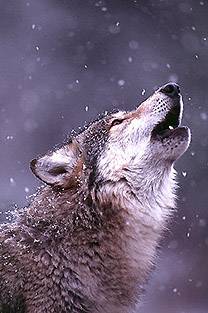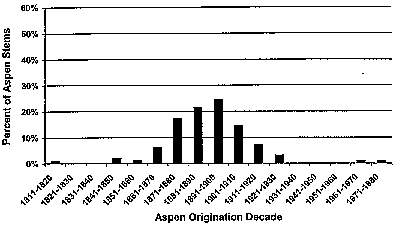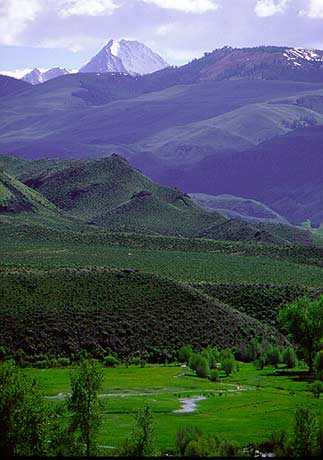Trophic
dynamics in the ecosystem in regard to the presence of wolves
 There
is a great deal of evidence supporting the changes in trophic cascades in regard
to the presence of wolves in an ecosystem. Introducing a top predator into a
top-down ecosystem will have a cascading influence down ecosystem levels. Moose
populations are influenced by the number of wolves, and therefore the intensity
of wolf predation is evidence that trophic cascades occur in terrestrial ecosystems
where top predators are the dominant high level consumers (Estes, 1996). McLaren
(1994) studied wolves on Isle Royale and found that during 1988-1991, the wolf
population had reached an unprecedented low, which was correlated with moose
populations reaching a new high level, accompanied by strong suppression of
balsam fir (Abies balsamea) growth. This is a 3-trophic level system dominated
by top-down control. Moose (Alces alces) herbivory suppressed foliar biomass
and annual wood accrual on the firs (Ripple and Larson, 2000). The growth of
trees in this study was determined using tree-ring analysis. This was concluded
after observations confirmed that fir growth rates decreased when wolf density
decreased, due to an increase in moose density.
There
is a great deal of evidence supporting the changes in trophic cascades in regard
to the presence of wolves in an ecosystem. Introducing a top predator into a
top-down ecosystem will have a cascading influence down ecosystem levels. Moose
populations are influenced by the number of wolves, and therefore the intensity
of wolf predation is evidence that trophic cascades occur in terrestrial ecosystems
where top predators are the dominant high level consumers (Estes, 1996). McLaren
(1994) studied wolves on Isle Royale and found that during 1988-1991, the wolf
population had reached an unprecedented low, which was correlated with moose
populations reaching a new high level, accompanied by strong suppression of
balsam fir (Abies balsamea) growth. This is a 3-trophic level system dominated
by top-down control. Moose (Alces alces) herbivory suppressed foliar biomass
and annual wood accrual on the firs (Ripple and Larson, 2000). The growth of
trees in this study was determined using tree-ring analysis. This was concluded
after observations confirmed that fir growth rates decreased when wolf density
decreased, due to an increase in moose density.
 On
Isle Royale, balsam fir is 59% of the moose's diet in winter (McLaren, 1994).
Over the course of time, the sensitivity of the balsam fir population to moose
numbers became obvious; in 1848 there was 46% abundance of over-story, 1978
it had dropped to 13% over-story, and by 1994 it was down to approximately 5%
over-story. On the Island there were other forage species responding to increasing
herbivory similar to the response of fir. In neighboring islands where moose
numbers were much lower by comparison, there was greater over-story fir growth
(McLaren, 1994). On Isle Royale, big herbivores, moose, are limited in number
not by the wolf, but by the primary supply of vegetation (Zimen, 1981). As mentioned
earlier, ungulates are poor self-regulators. Although there are alternative
means of self-regulation, possibly disease or parasites, without predation ungulate
populations would significantly expand and deplete much of their own resources
and damage vegetation. From this, one might conclude that reintroducing a top
predator like the wolf is bound to benefit the entire ecosystem in that it reestablishes
balance and natural cycles.
On
Isle Royale, balsam fir is 59% of the moose's diet in winter (McLaren, 1994).
Over the course of time, the sensitivity of the balsam fir population to moose
numbers became obvious; in 1848 there was 46% abundance of over-story, 1978
it had dropped to 13% over-story, and by 1994 it was down to approximately 5%
over-story. On the Island there were other forage species responding to increasing
herbivory similar to the response of fir. In neighboring islands where moose
numbers were much lower by comparison, there was greater over-story fir growth
(McLaren, 1994). On Isle Royale, big herbivores, moose, are limited in number
not by the wolf, but by the primary supply of vegetation (Zimen, 1981). As mentioned
earlier, ungulates are poor self-regulators. Although there are alternative
means of self-regulation, possibly disease or parasites, without predation ungulate
populations would significantly expand and deplete much of their own resources
and damage vegetation. From this, one might conclude that reintroducing a top
predator like the wolf is bound to benefit the entire ecosystem in that it reestablishes
balance and natural cycles.
A trophic structure involving wolves, elk, and aspen
trees was discovered in Yellowstone. The presence of the wolf may increase aspen
growth indirectly, through trophic structure interactions in which predation
regulates terrestrial systems (Ripple and Larson, 2000). Kay (1990 cited in
Ripple and Larson, 2000) and Wagner et al. (1995 cited in Ripple and Larson,
2000) stated that the decline of over-story aspen is due primarily to over browsing
caused by an over abundance of elk. This is because in the winter, elk browse
the leaders off aspen suckers and this prevents growth. Thus the aspen population
in the strong presence of elk has limited growth. Aspen growth was examined
by looking at the ages and sizes of aspen trees. Data from the study found that
approximately 10% of the current over-story of aspen originated before 1871,
85% of the current over-story is grew between 1871 and 1920, and only 5% of
the over-story is from after 1921 (Ripple and Larson, 2000).

The years 1872-1886 were the market hunting
era in YNP, where large animal populations were being decimated, including bison,
elk, wolves and other large animals. During this time browsing pressure on aspen
was minimal. Populations were allowed to reestablish after this era, including
wolves, which were increased in numbers by 1912. Then came concerns for protecting
ungulate populations, and thus the effective removal of the wolf in YNP from
1914-1926 (Ripple and Larson, 2000). The study found that aspen over-story recruitment
ceased during the same years that wolves were removed from YNP.
Canada's Jasper National Park (Dekker, 1985; Dekker et
al., 1996 cited in Ripple and Larson, 2000) noted an increase in aspen over-story
recruitment in areas frequented by wolves. Furthermore, White et al. (1998 cited
in Ripple and Larson, 2000) suggested that aspen might be regenerating in areas
avoided by elk, because of a predator avoidance strategy. The trophic connection
observed in YNP was supported by observed inverse relationships between wolf
populations and aspen recruitment in Sweden, Finland, and northern Russia (Angelstam,
1998 cited in Ripple and Larson, 2000). Brandli (1995 cited in Breitenmoser,
1998) found in Switzerland a clear correlation between estimated ungulate density,
damaged trees, and lack of natural regeneration. Substantial evidence suggests
that wolves may have a positive impact on aspen over-story through a trophic
cascade involving elk populations, movements, and browsing patterns.
One proposed possible trophic relationship was that with
wolves present, elk would be killed, the carcasses would benefit the grizzly
bear and its population would expand, in turn increasing predation on elk, which
would contribute to a change towards a decline in elk herbivory effects (Ripple
and Larson, 2000). This grizzly reinforcement hypothesis supports the
return of the wolf where competition between large carnivores creates coexistence
beneficial to each species as well as the environment. Another study on wolf-bear
interactions uncovered the importance of their coexistence, but was discovered
through different observations of grizzly populations. Grizzly bears in Yellowstone
are fairly small and low in density (Estes, 1996). This might be explainable
through a trophic relationship. The bears have a limited availability of fruits
at their disposal, which is caused by elk overgrazing as a result of the absence
of wolves in this ecosystem (Estes, 1996).
 In
Mount McKinley National Park, biologists predict that wolves serve to keep the
caribou population in check, and without wolves limiting caribou numbers the
caribou might populate so extensively that vast areas of lichen range would
be severely damaged. Trophic cascades are prevalent in all ecosystems and the
importance of which are often only identified after a key element has been removed.
In
Mount McKinley National Park, biologists predict that wolves serve to keep the
caribou population in check, and without wolves limiting caribou numbers the
caribou might populate so extensively that vast areas of lichen range would
be severely damaged. Trophic cascades are prevalent in all ecosystems and the
importance of which are often only identified after a key element has been removed.
The eradication of wolves in the northwest United States
disrupted many natural functions and pathways that were one a key part of the
ecosystem. Now this top predator is being put back into the ecosystem and the
wolf will find its role and its importance in the community and ecosystem functions.
The definition of an ecosystem means that no single component is independent
of all other components. Each organism, species, and process are linked somehow.
Many connections are unlikely and surprising, as is described above, but all
are critical to a balanced productive functioning ecosystem.
return to Ecosystem
Response
return home
 There
is a great deal of evidence supporting the changes in trophic cascades in regard
to the presence of wolves in an ecosystem. Introducing a top predator into a
top-down ecosystem will have a cascading influence down ecosystem levels. Moose
populations are influenced by the number of wolves, and therefore the intensity
of wolf predation is evidence that trophic cascades occur in terrestrial ecosystems
where top predators are the dominant high level consumers (Estes, 1996). McLaren
(1994) studied wolves on Isle Royale and found that during 1988-1991, the wolf
population had reached an unprecedented low, which was correlated with moose
populations reaching a new high level, accompanied by strong suppression of
balsam fir (Abies balsamea) growth. This is a 3-trophic level system dominated
by top-down control. Moose (Alces alces) herbivory suppressed foliar biomass
and annual wood accrual on the firs (Ripple and Larson, 2000). The growth of
trees in this study was determined using tree-ring analysis. This was concluded
after observations confirmed that fir growth rates decreased when wolf density
decreased, due to an increase in moose density.
There
is a great deal of evidence supporting the changes in trophic cascades in regard
to the presence of wolves in an ecosystem. Introducing a top predator into a
top-down ecosystem will have a cascading influence down ecosystem levels. Moose
populations are influenced by the number of wolves, and therefore the intensity
of wolf predation is evidence that trophic cascades occur in terrestrial ecosystems
where top predators are the dominant high level consumers (Estes, 1996). McLaren
(1994) studied wolves on Isle Royale and found that during 1988-1991, the wolf
population had reached an unprecedented low, which was correlated with moose
populations reaching a new high level, accompanied by strong suppression of
balsam fir (Abies balsamea) growth. This is a 3-trophic level system dominated
by top-down control. Moose (Alces alces) herbivory suppressed foliar biomass
and annual wood accrual on the firs (Ripple and Larson, 2000). The growth of
trees in this study was determined using tree-ring analysis. This was concluded
after observations confirmed that fir growth rates decreased when wolf density
decreased, due to an increase in moose density.  On
Isle Royale, balsam fir is 59% of the moose's diet in winter (McLaren, 1994).
Over the course of time, the sensitivity of the balsam fir population to moose
numbers became obvious; in 1848 there was 46% abundance of over-story, 1978
it had dropped to 13% over-story, and by 1994 it was down to approximately 5%
over-story. On the Island there were other forage species responding to increasing
herbivory similar to the response of fir. In neighboring islands where moose
numbers were much lower by comparison, there was greater over-story fir growth
(McLaren, 1994). On Isle Royale, big herbivores, moose, are limited in number
not by the wolf, but by the primary supply of vegetation (Zimen, 1981). As mentioned
earlier, ungulates are poor self-regulators. Although there are alternative
means of self-regulation, possibly disease or parasites, without predation ungulate
populations would significantly expand and deplete much of their own resources
and damage vegetation. From this, one might conclude that reintroducing a top
predator like the wolf is bound to benefit the entire ecosystem in that it reestablishes
balance and natural cycles.
On
Isle Royale, balsam fir is 59% of the moose's diet in winter (McLaren, 1994).
Over the course of time, the sensitivity of the balsam fir population to moose
numbers became obvious; in 1848 there was 46% abundance of over-story, 1978
it had dropped to 13% over-story, and by 1994 it was down to approximately 5%
over-story. On the Island there were other forage species responding to increasing
herbivory similar to the response of fir. In neighboring islands where moose
numbers were much lower by comparison, there was greater over-story fir growth
(McLaren, 1994). On Isle Royale, big herbivores, moose, are limited in number
not by the wolf, but by the primary supply of vegetation (Zimen, 1981). As mentioned
earlier, ungulates are poor self-regulators. Although there are alternative
means of self-regulation, possibly disease or parasites, without predation ungulate
populations would significantly expand and deplete much of their own resources
and damage vegetation. From this, one might conclude that reintroducing a top
predator like the wolf is bound to benefit the entire ecosystem in that it reestablishes
balance and natural cycles.  In
Mount McKinley National Park, biologists predict that wolves serve to keep the
caribou population in check, and without wolves limiting caribou numbers the
caribou might populate so extensively that vast areas of lichen range would
be severely damaged. Trophic cascades are prevalent in all ecosystems and the
importance of which are often only identified after a key element has been removed.
In
Mount McKinley National Park, biologists predict that wolves serve to keep the
caribou population in check, and without wolves limiting caribou numbers the
caribou might populate so extensively that vast areas of lichen range would
be severely damaged. Trophic cascades are prevalent in all ecosystems and the
importance of which are often only identified after a key element has been removed.